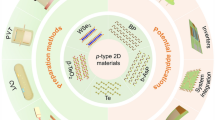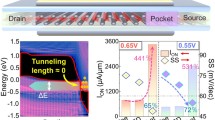Abstract
The effect of anchoring atom and electrostatic gate on the electron transport through gated thiophene single molecular device is studied by utilizing non-equilibrium Green’s function coupled with self-consistent extended Huckel theory. Gated gold–molecule–gold junctions are built using thiophene (Tp) molecule as functional component and sulphur (S) and selenium (Se) as anchoring atoms in field effect transistor (FET) configuration. The electron transport analysis of the gated thiophene single molecular device is investigated through the current–voltage and the electron transmission spectra. The results show that the anchoring atoms modulate the transport nature of these devices in a controlled manner. We find that the S–Tp–S device produces larger current than Se–Tp–Se device. Also we studied the effect of electrostatic gating on S–Tp–S and Se–Tp–Se device. We find that, positive bias or negative bias for Vg, will correspondingly, raise or lower the transmission coefficients T(E) in relation to the Fermi level (EF) for both the devices. Our results show that magnitude of Isd current varies more than one order for same Vsd over different Vg bias for S–Tp–S device, whereas for Se–Tp–Se device Isd current varies more than five times for same Vsd over different Vg bias. Se–Tp–Se device shows gate controlled NDR behavior. Finally, we demonstrated the application of using thiophene based single molecular FET to realize five basic logic gates very low Vsd bias. The key feature of the suggested design is the opportunity of demonstrating various logic gates with just one molecular unit transistor and demonstrated at very low Vsd bias.








Similar content being viewed by others
References
G.E. Moore, Electronics 38, 114 (1965)
B. Hoefflinger, Chips 2020 (Springer, Berlin, 2011), pp. 161-174
A. Aviram, M.A. Ratner, Chin. Phys. Lett. 29, 277 (1974)
C. Joachim, J.K. Gimzewski, A. Aviram, Nature 408, 541 (2000)
J. Yao, Y. Li, Z. Zou, H. Wang, Y. Shen, Superlattices Microstruct. 51, 396 (2012)
H. Song, Y. Kim, Y.H. Jang, H. Jeong, M.A. Reed, T. Lee, Nature 462, 1039 (2009)
K. Xiao, Y. Liu, T. Qi, W. Zhang, F. Wang, J. Gao, W. Qiu, Y. Ma, G. Cui, S. Chen, X. Zhan, J. Am. Chem. Soc. 127, 13281 (2005)
B. Xu, X. Xiao, X. Yang, L. Zang, N. Tao, J. Am. Chem. Soc. 127, 2387 (2005)
W. Jing, L. Yun-Ye, C. Hao, W. Peng, R. Note, H. Mizuseki, Y. Kawazoe, Chin. Phys. Lett. 27, 067303 (2010)
A. Mahmoud, P. Lugli, J. Appl. Phys. 116, 204504 (2014)
Y. Xu, B. Cui, G. Ji, D. Li, D. Liu, Phys. Chem. Chem. Phys. 15, 832 (2013)
S.M. Kang, Y. Leblebici, CMOS Digital Integrated Circuits Analysis Design, 4th edn. (McGraw-Hill, USA, 2002)
J.M. Wang, S.C. Fang, W.S. Feng, IEEE J. Solid State Circuits 29, 780 (1994)
Y. Xu, C. Fang, B. Cui, G. Ji, Y. Zhai, D. Liu, Appl. Phys. Lett. 99, 043304 (2011)
X.Y. Feng, Z. Li, J. Yang, J. Phys. Chem. C 113, 21911 (2009)
M.J. Li, H. Xu, K.Q. Chen, M.Q. Long, Phys. Lett. A 376, 1692 (2012)
W.W. Cheng, Y.X. Liao, H. Chen, R. Note, H. Mizuseki, Y. Kawazoe, Phys. Lett. A 326, 412 (2004)
S. Sen, S. Chakrabarti, Comput. Mater. Sci. 4, 889 (2009)
C.P. Kala, P.A. Priya, D.J. Thiruvadigal, J. Comput. Theor. Nanosci. 10, 213 (2012)
Y. Luo, C.K. Wang, Y. Fu, Chem. Phys. Lett. 369, 299 (2003)
C.P. Kala, P.A. Priya, D.J. Thiruvadigal, Commun. Theor. Phys. 59, 649 (2013)
R.N. Wang, X.H. Zheng, Z.X. Dai, H. Hao, L.L. Song, Z. Zeng, Phys. Lett. A 375, 657 (2011)
S. Jalili, R. Ashrafi, Phys. E 43, 960 (2011)
F. Zahid, M. Paulsson, E. Polizzi, A.W. Ghosh, L. Siddiqui, S. Datta, J. Chem. Phys. 123, 064707 (2005)
ATOMISTISTIX TOOLKIT version 12.8.2, Quantum Wise A/S (www.quantumwise.com)
D.Q. Andrews, G.C. Solomon, R.P. Van Duyne, M.A. Ratner, J. Am. Chem. Soc. 130, 17309 (2008)
H. Fang, R.Z. Wang, S.Y. Chen, M. Yan, X.M. Song, B. Wang, Appl. Phys. Lett. 98, 082108 (2011)
M. Brandbyge, J.L. Mozos, P. Ordejón, J. Taylor, K. Stokbro, Phys. Rev. B 65, 165401 (2008)
K. Stokbro, D.E. Petersen, S. Smidstrup, A. Blom, M. Ipsen, K. Kaasbjerg, Phys. Rev. B 82, 075420 (2010)
Acknowledgments
The authors wish to thank Department of Science and Technology, Government of India. This work was supported by a grant from DST-FIST, Govt. of India (Grant Ref. No SR/FST/PSI-010/2010).
Author information
Authors and Affiliations
Corresponding author
Rights and permissions
About this article
Cite this article
Hariharan, R.M., Thiruvadigal, D.J. Effect of anchoring atom and electrostatic gating on the electronic transport properties in single molecular electronic devices. J Mater Sci: Mater Electron 28, 601–609 (2017). https://doi.org/10.1007/s10854-016-5564-4
Received:
Accepted:
Published:
Issue Date:
DOI: https://doi.org/10.1007/s10854-016-5564-4




